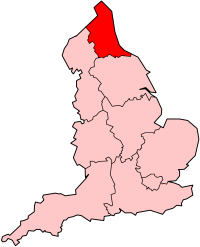Durham Coast Line
The Durham Coast Line is an approximately 39.5 miles (63.6 km) railway line running between Newcastle and Middlesbrough in North East England. Heavy rail passenger services, predominantly operated Northern Trains, and some freight services operate over the whole length of the line; it provides an important diversionary route at times when the East Coast Main Line is closed. However the tracks between a junction just south of Sunderland station and Pelaw Junction (just east of Pelaw Metro station) are shared with light rail services of the Tyne and Wear Metro's Green Line.
| Durham Coast Line | |
|---|---|
 Looking south-east along the line towards Hartlepool, as it leaves Seaham. | |
| Overview | |
| Type | Heavy rail |
| System | National Rail |
| Status | Operational |
| Locale | |
| Termini | Newcastle Middlesbrough |
| Stations | 11 |
| Operation | |
| Opened | 1833–1905 |
| Owner | Network Rail |
| Operator(s) | |
| Rolling stock |
|
| Technical | |
| Line length | 39.5 miles (63.6 km)[1] |
| Number of tracks | 2 |
| Track gauge | 4 ft 8 1⁄2 in (1,435 mm) |
| Electrification | 1,500 V DC (between Pelaw Junction & Sunderland South Junction) |
Durham Coast Line | |||||||||||||||||||||||||||||||||||||||||||||||||||||||||||||||||||||||||||||||||||||||||||||||||||||||||||||||||||||||||||||||||||||||||||||||||||||||||||||||||||||||||||||||||||||||||||||||||||||||||||||||||||||||||||||||||||||||||||||||||||||||||||||||||||||||||||||||||||||||||||||||||||||||||||||||||||||||||||||||||||||||||||||||||||||||||||||||||||||||||||||||||||||||||||||||||||||||||||||||||||||||||||||||||||||||||||||||||||||||||||||||||||||||||||||||||||||||||||||||||||||||||||||||||||||||||||||||||||||||||||||||||||||||||||||||||||||||||||||||||||||||||||
|---|---|---|---|---|---|---|---|---|---|---|---|---|---|---|---|---|---|---|---|---|---|---|---|---|---|---|---|---|---|---|---|---|---|---|---|---|---|---|---|---|---|---|---|---|---|---|---|---|---|---|---|---|---|---|---|---|---|---|---|---|---|---|---|---|---|---|---|---|---|---|---|---|---|---|---|---|---|---|---|---|---|---|---|---|---|---|---|---|---|---|---|---|---|---|---|---|---|---|---|---|---|---|---|---|---|---|---|---|---|---|---|---|---|---|---|---|---|---|---|---|---|---|---|---|---|---|---|---|---|---|---|---|---|---|---|---|---|---|---|---|---|---|---|---|---|---|---|---|---|---|---|---|---|---|---|---|---|---|---|---|---|---|---|---|---|---|---|---|---|---|---|---|---|---|---|---|---|---|---|---|---|---|---|---|---|---|---|---|---|---|---|---|---|---|---|---|---|---|---|---|---|---|---|---|---|---|---|---|---|---|---|---|---|---|---|---|---|---|---|---|---|---|---|---|---|---|---|---|---|---|---|---|---|---|---|---|---|---|---|---|---|---|---|---|---|---|---|---|---|---|---|---|---|---|---|---|---|---|---|---|---|---|---|---|---|---|---|---|---|---|---|---|---|---|---|---|---|---|---|---|---|---|---|---|---|---|---|---|---|---|---|---|---|---|---|---|---|---|---|---|---|---|---|---|---|---|---|---|---|---|---|---|---|---|---|---|---|---|---|---|---|---|---|---|---|---|---|---|---|---|---|---|---|---|---|---|---|---|---|---|---|---|---|---|---|---|---|---|---|---|---|---|---|---|---|---|---|---|---|---|---|---|---|---|---|---|---|---|---|---|---|---|---|---|---|---|---|---|---|---|---|---|---|---|---|---|---|---|---|---|---|---|---|---|---|---|---|---|---|---|---|---|---|---|---|---|---|---|---|---|---|---|---|---|---|---|---|---|---|---|---|---|---|---|---|---|---|---|---|---|---|---|---|---|---|---|---|---|---|---|---|---|---|---|---|---|---|---|---|---|---|---|---|---|---|---|---|---|---|---|---|---|---|---|---|---|---|---|---|---|---|---|---|---|---|---|---|---|---|---|---|---|---|---|---|---|---|---|---|---|---|---|---|---|---|---|---|---|---|---|---|---|---|---|---|---|---|---|---|---|---|---|---|---|---|---|---|---|---|---|---|---|---|---|---|---|---|---|---|---|---|---|---|---|---|---|---|---|---|---|---|---|---|---|---|---|---|---|---|---|---|---|---|---|---|---|---|---|---|---|---|---|---|---|---|---|---|---|---|---|---|
| |||||||||||||||||||||||||||||||||||||||||||||||||||||||||||||||||||||||||||||||||||||||||||||||||||||||||||||||||||||||||||||||||||||||||||||||||||||||||||||||||||||||||||||||||||||||||||||||||||||||||||||||||||||||||||||||||||||||||||||||||||||||||||||||||||||||||||||||||||||||||||||||||||||||||||||||||||||||||||||||||||||||||||||||||||||||||||||||||||||||||||||||||||||||||||||||||||||||||||||||||||||||||||||||||||||||||||||||||||||||||||||||||||||||||||||||||||||||||||||||||||||||||||||||||||||||||||||||||||||||||||||||||||||||||||||||||||||||||||||||||||||||||||
The line developed from several small competing independent railway companies during the first half of the 19th century which ultimately came under the control of the North Eastern Railway. It was under their direction that these lines were gradually linked together to eventually create the Durham Coast Line in 1905.[3]
History
Origins
The current route of the Durham Coast Line has its origins in some of the earliest locomotive-operated railways in North East England. The oldest section of the line in use today is that between North Shore Junction and Norton South Junction,[4][5] constructed by the Clarence Railway. As with many of the early railways, this line was constructed primarily for the transportation of coal from western and central areas of the Durham Coalfield to the River Tees at North Shore (in Stockton), and Port Clarence. Despite major financial difficulties, this line was opened to mineral traffic in 1833, but did not carry passengers until July 1835, when a service was introduced between Coxhoe and Stockton (Clarence).[4][5]

The opening of the Clarence was closely followed by the Hartlepool Dock & Railway, a similar concern, intended to link the collieries surrounding the City of Durham, to the coast at Hartlepool (rather than the River Tees). The HD&R was first authorised by an Act of Parliament obtained on 1 June 1832 to construct a 14-mile railway from Moorsley (near Houghton-le-Spring) to Hartlepool with several short branches to serve collieries surrounding the line. The company obtained a further Act of 16 June 1834 which permitted construction of an additional branch to Gilesgate in the City of Durham.[6] However competition from other railways[7] meant that the H&DR main line only reached as far as Haswell and most of its branches were either cut short or left unbuilt; the curtailed line opened for mineral traffic on 23 November 1835[5] and passengers four years later.
The Durham & Sunderland Railway opened to both passenger and mineral traffic between Sunderland Town Moor, and collieries at Hetton-le-Hole and Haswell in 1836,[8] competing directly with the HD&R for coal traffic from the latter.[4] However, it was the D&SR which constructed the first significant north–south section of the Durham Coast Line, that between Ryhope Grange Junction and Ryhope.[3] In conjunction with the HD&R, the D&SR thus enabled passengers to travel between Sunderland and Hartlepool for the first time by rail, although passengers had to change stations at Haswell at the time.[6]
Tyne to Tees rail passenger travel then quickly became possible (with three changes of station) following the opening of Brandling Junction Railway between Oakwellgate (Gateshead) and Wearmouth (Monkwearmouth) on 5 September 1839[9] and the Stockton & Hartlepool Railway between the Clarence at Billingham-on-Tees, and a new terminus near West Hartlepool docks on 10 February 1841.[4] The opening of the High Level Bridge over the River Tyne on 27 September 1849 subsequently extened this route though to Newcastle.[10]
On its opening on 15 May 1852, the Leeds Northern Railway[11] linked directly to the Clarence and, in doing so, provided the route with a link to the south.[4] One year after the LNR reached Stockton, the newly created West Hartlepool Harbour & Railway (now owners of the Clarence lines) began to share the LNR station at North Stockton.[4]
The last of the independent railways that became part of the modern DCL was the Londonderry, Seaham & Sunderland Railway of 1854, constructed, primarily, to enable coal traffic from the extensive Londonderry Railway colliery railway network to be diverted from Seaham Harbour (which had become unable to handle the large volumes of coal passing through it) to the recently constructed South Dock at Sunderland[8] and thus followed route which parallel the D&SR north of Ryhope. Like the rest of the railways discussed here, the LS&SR later introduced a passenger service on 2 July 1855 between Seaham and Hendon Burn.[9][8]
Amalgamations and the creation of a through route
The Clarence had struggled financially, almost continuously since its construction began, and so the more successful Stockton & Hartlepool Railway took out a 21-year lease on it in 1844 which became permanent in 1851. The two companies were then formally amalgamated together and with the West Hartlepool Harbour & Dock Company on 17 May 1853, to form the West Hartlepool Harbour & Railway.[4]
Meanwhile, as part of its expansion, Newcastle & Darlington Junction Railway had took over the BJR on 1 September 1844,[12] and then purchased the D&SR in 1846.[13] Following its amalgamation with the Great North of England Railway, the Newcastle & Darlinton Junction Railway became the York & Newcastle Railway, and took out a lease on the HD&R[6] before both became part of the York, Newcastle & Berwick Railway under an Act of 22 July 1848. Finally, in 1854, the YN&BR, LNR, and York & North Midland Railway were amalgamated to form the North Eastern Railway which eventually absorbed the WHH&R in 1865.[4] Thus, from 1865, one company was in control of the whole through route between Middlesbrough, Hartlepool, Sunderland and Newcastle, although the lines remained largely unconnected.
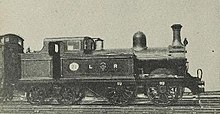
Thus a series of improvements were initiated by the NER to better integrate is fragmented network. For the DCL, one of the first of these saw the construction of a new curve to link the ex-LNR Stockton branch to the former network of Stockton & Darlington Railway (absorbed by the NER in 1863), which linking Middlesbrough to lines towards Stockton and Hartlepool.[4] Combined with the 1873 realignment of the south to east curve at Norton Junction, which eased the severity of its curvature,[4] this massively improved the connections between Hartlepool and the rest of the Teesside region.
The rope-worked 1 in 34 incline at Hesleden Bank was realigned in 1874 to reduce the gradient to that of 1 in 52 and thus enable locomotive working over the entire Hartlepool-Sunderland route.[6]
In 1877, the NER constructed a new chord between the ex-HD&R and ex-D&SR lines at Haswell and replaced the previously separate terminus stations with a new through station.[14] In the same year, at Hartlepool, they also constructed a direct link between the ex-HD&R and former Stockton & Hartlepool Railway lines which skirts around the western edge of the docks and replaced a more circuitous link through them.[4] Both the ex-Stockton & Hartlepool Railway and ex-HD&R termini were replaced by new stations at West Hartlepool (in 1880)[4] and Hartlepool (in 1878),[14] respectively.
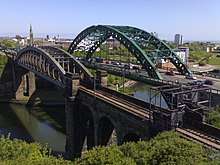
However, of these links constructed by the NER, arguably the most significant was the Monkwearmouth Junction Line of 1879[15] which linked the ex-D&SR lines at Ryhope Grange Junction to the ex-BJR lines at Monkwearmouth.[8][3] This involved the construction of the Monkwearmouth Railway Bridge over the River Wear, a new station at Sunderland Central, and tunnels on either side of the station.[8] Following the opening of Sunderland Central station, NER and LS&SR services were diverted away from the earlier termini and focussed in one location for the first time.[8]
Following the completion of the improvements of the 1870s, the Durham Coast Line could be operated as a through route but, having not been constructed for such a purpose, doing so it remained challenging. One major issue was that any services running between Hartlepool and Sunderland still had to ascend or descend both the 1:44 incline at Seaton Bank, and the aforementioned incline at Hesleden Bank.[4] To alleviate this, the NER developed plans to construct a new, more direct, line along the coast. Construction of this new line between Seaham Colliery on the LS&SR, and Hart Junction on the ex-HD&R route was sanctioned in 1894–95.[4] However its construction was contingent on the NER purchasing the Londonderry Railway's Seaham to Sunderland route and this was not agreed until 1900 when the NER agreed to pay £387,000 for it.[16]
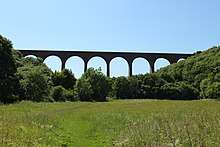
This new coastal line had to cross the denes at Hawthorn, Castle Eden and Crimdon, each requiring a substantial viaduct; one of the most imposing of these, Castle Eden Viaduct, is 141 feet (43 m) from ground to rail level, and consists of 10 arches, each with a span of 60 feet (18 m).[17] The construction of these viaducts required the opening of a special brickfield and, in the case of Castle Eden Viaduct, the creation of a temporary 800 feet (240 m) cableway across the valley.[17]
The line opened on 1 April 1905, with new stations constructed at Blackhall Rocks, Horden and Easington,[18] to serve the new villages that had been created to house workers from the new coastal collieries which came into existence thanks to the provision of the railway.
The NER became part of the London & North Eastern Railway, as part of the 1923 grouping.[4] Despite them having already begun to experience a decline in traffic, due to competition from road vehicles,[8] the LNER did provide some improvements to the line. Further stations were opened at Blackhall Colliery on the NER-built Seaham to Hart line in 1936,[17] and at Seaburn on the former Brandling Junction Railway line in 1937.[7]
Decline
On 1 January 1948, the London & North Eastern Railway became part of the nationalised British Railways, and, along with other lines in the North East, the Durham Coast Line became part of its North Eastern Region.
By the 1950s, passenger and goods traffic across the country was in decline, due to completion from road transport, and as a consequence, most of the earlier east–west lines from which the DCL had developed began to lose passenger services.[4] These closures included the inland West Hartlepool to Sunderland route through Haswell (the main line between the two towns until 1905), which lost its passenger service on 9 June 1952.[5]
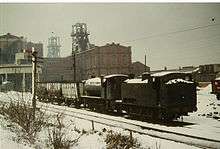
However the DCL itself was not seriously affected by the closures, until it began to lose stations from 1960 onwards. Even the Beeching Report only recommended the closure of the remaining three intermediate stations between West Hartlepool and Seaham.[19] This occurred on 4 May 1964, when stopping passenger services along this section of the line were withdrawn.[19]
Despite this apparent degradation of passenger services, during this period British Rail replaced the original station at Billingham with a more one, closer to the new town centre, on 7 November 1966.[20]
Freight traffic on the line continued to thrive, whilst the collieries along the line (and a few short sections of the older east–west lines which had been retained as branches for mineral traffic) were still in operation. Owing to the relatively recent development of the coastal collieries, many of them survived until the late 1980s and early 1990s.
Nonetheless, the decline of the British coal industry meant that this traffic, too, was steadily lost between the cessation of mining operations at Blackhall Colliery, on 16 April 1981[21] and that at Wearmouth Colliery, on 24 November 1993.[22]
In the early 1980s Greatham station saw its services reduced before full closure on 24 November 1991.[23]
Recent History

The former British Rail stations on the Durham Coast Line at Felling and Pelaw were closed on 5 November 1979, in order to enable their conversion for use by the Tyne and Wear Metro.[24] They were replaced by a new station at Heworth, opened on the same day.[24] To give Metro trains dedicated infrastructure British Rail passenger trains services were subsequently diverted onto the previously freight-only relief lines which paralled the passenger lines between Gateshead and Pelaw Junction.[24] The Metro line between Haymarket and Heworth opened in November 1981, and as a result, the British Rail station at Gateshead was closed just one week later.[25]
In 1996, HM Rail Inspectorate approved plans to extend the Metro between Pelaw, Sunderland and South Hylton, along tracks shared with heavy rail DCL services, subject to funding being raised.[26] A grant of £15 million was awarded by the European Regional Development Fund, but this was subject to the Tyne and Wear Passenger Transport Executive (Nexus) being able to obtain £35 million of central government funding.[26] Such funding was awarded in 1999 and, along with £8 million provided by Nexus and a further £40 million invested by Railtrack, enabled construction work to commence in June 2000.[26] As part of this project, three new purpose-built Metro stations were constructed along the Durham Coast Line at Fellgate, Stadium of Light and St Peter's, the latter of which was constructed close to the site of the long-closed Monkwearmouth station. Existing rail stations at Brockley Whins, East Boldon and Seaburn were converted for Metro services.[26]
The project also involved the electrification of the Durham Coast Line between Pelaw Junction and Sunderland South Junction, and an upgrade to signalling on that section of the line.[26] The non-standard electrification system used by the Metro makes this section of the DCL the only Network Rail line to still use the 1,500V DC overhead line system.[26]

The Metro's South Hylton extension was officially opened by Queen Elizabeth II on 7 May 2002, as part of her Golden Jubilee celebrations.[27]
Under the supervision of Phase 1 the Tees Valley Rail Strategy, the DCL saw service provision become hourly between Newcastle and Hartlepool from 2000. The ultimate goal of a half-hourly service and new stations (Phase 2) was put on hold when the Strategic Rail Authority came into being and funding disappeared.
After many years of development work undertaken by Durham County Council, £10.5 million of funding was agreed in July 2017 to open a new station at Horden,[28] approximately 200 yards (180 m) north of the site earlier[29] (1905-1964) station.[19] This included £4.4 million from the second round of the Department for Transport's New Stations Fund and additional contributions from Durham County Council and the North East Combined Authority.[30] After some delay,[31] the new Horden station opened on 29 June 2020.[6][14]
Passenger services
As of the December 2019 change, Northern Trains run an hourly service along the Durham Coast Line between Newcastle and Middlesbrough. Most trains run through from Hexham (with some from Carlisle), and continue through to Nunthorpe (some run as far as Whitby).[32][33]
Predominantly, rolling stock on the Durham Coast Line consists of Northern Trains's Class 156 and Class 158 diesel multiple units. These fleets were both introduced in the late 1980s but are currently being fitted with free Wi-Fi, power sockets, on-board passenger information displays, and an interior refresh as part of Northern's ongoing refurbishment programme.[34][35] Prior to their withdrawal in late 2019, Northern Class 142 'Pacer' DMUs had also operated on this route.[36]
Between Pelaw Junction and Sunderland, the line is shared with the Tyne and Wear Metro, with Class 994 'Metrocars' providing up to five local trains per hour, on the South Hylton to Airport Green Line.[37]
Other rolling stock includes Grand Central's Class 180 diesel multiple units, which provide five daily services between Sunderland and London King's Cross,[38] and LNER's Class 800 Azuma used on the once-daily service to and from Sunderland and London King's Cross, previously introduced by Virgin Trains East Coast in December 2015.[39]
Until 2004, First TransPennine Express operated services along the northern section of the Durham Coast Line, using Class 158 diesel multiple units, as part of their service from Sunderland to Liverpool Lime Street.
Freight Services
Despite the decline in the heavy industry in the North East of England, the Durham Coast Line still retains a regular freight service over the line. Steel coil is railed into the Tata Steel plant at Hartlepool, and pipes are then taken out to Leith, and the Far North of Scotland for the North Sea gas and oil industry. Spent nuclear rods are also railed out for re-processing at Sellafield from Hartlepool Nuclear Power Station. Cement is delivered to Seaham Docks, and scrap metal is forwarded from Stockton on Tees to Celsa EAF works in Cardiff. Tyne Dock has a trailing connection to the Durham Coast Line in both directions, near to the Metro station at Brockley Whins.[40]
The docks at Sunderland were recently reconnected by Network Rail, in the anticipation of a return to rail traffic. This has yet to come to fruition.[41]
Despite the wide range of large industrial complexes at Seal Sands, very few of these organisations use rail as a method of transport.
References
- "Delivering a better railway for a better Britain: Route Specifications 2019 London North Eastern and East Midlands" (PDF). Network Rail. April 2019. Retrieved 2 March 2020.
- "List of dates from 1 January 1985 to 20 January 2006 of last passenger trains at closed BR (or Network Rail stations since privatisation)". Department for Transport Website: Freedom of Information Act responses, February 2006. Department for Transport. 2006. Archived from the original on 7 June 2009. Retrieved 6 February 2012.
- Line Diagrams of the North Eastern Railway: Stockton - Hartlepool - Sunderland - Newcastle. North Eastern Railway Association. 2008. p. 1. ISBN 9781873513682.
- Hill, Norman (2001). Teesside Railways A View from the Past. Ian Allan Publishing Ltd. pp. 4, 8, 13, 17, 18, 23, 27, 28, 30, 42, 43, 45, 48, 58, 64, 66 & 67. ISBN 0711028036.
- Hoole, K. (1978). North Eastern Railway branch lines since 1925. Ian Allan Ltd. pp. 77 & 114. ISBN 0711008299.
- Hoole, K. (1986). Regional History of Railways of Great Britain Volume 4 The North East (Third ed.). Newton Abbot: David St John Thomas. pp. 149, 151 & 154. ISBN 0946537313.
- Hill, Norman (2001). Teesside Railways A View From The Past. Hersham: Ian Allan Publishing Ltd. pp. 17, 18, 23, 27 & 48. ISBN 0711028036.
- Sinclair, Neil T. (1985). Railways of Sunderland. Tyne and Wear County Council Museums. pp. 9, 14, 21, 42, 48, 54 & 62. ISBN 0905974247.
- Hoole, K. (1965). A Regional History of the Railways of Great Britain: volume 4: The North East. David and Charles. ISBN 0946537313.
- Addyman, John; Fawcett, Bill (1999). The High Level Bridge and Newcastle Central Station – 150 years across the Tyne. North Eastern Railway Association. ISBN 1873513283.
- Hoole, K. (1974). North Eastern Album. Littlehampton Book Services Ltd. p. 144. ISBN 9780711005631.
- Allen, Cecil J (1974) [1964]. The North Eastern Railway (Revised ed.). Ian Allan Ltd. p. 90. ISBN 0711004951.
- "Disused Stations: Durham Elvet Station". Disused Stations. Retrieved 13 September 2017.
- Hoole, K. (1985). Railways of East Durham. The Dalesman Publishing Company Ltd. p. 8. ISBN 0852068352.
- Tomlinson, W.W. (1915), The North Eastern Railway; its rise and development, Andrew Reid and Company, Newcastle; Longmans, Green and Company, London, p. 685
- Body, Geoffrey (1989). Railways of the Eastern Region. Volume 2: Northern operating area–PSL field guide. Patrick Stephens Limited. p. 150. ISBN 1852600721.
- Blackhall Between The Wars - Part One - The Colliery and its influence. Blackhalls Local History Group. 2004. pp. 47 & 49. ISBN 0954149211.
- British Railways Pre-Grouping Atlas & Gazetteer (6th ed.). Ian Allan Publishing Ltd. 2015. pp. Sheets 27 & 28. ISBN 9780711038172.
- Waller, Peter (2013). Rail Atlas The Beeching Era. Ian Allan Publishing ltd. pp. 67, 89, 97 & 104. ISBN 9780711035492.
- "Poster for the New Billingham Station – 1966". Retrieved 14 September 2017.
- "Durham Mining Museum - Blackhall Colliery". Durham Mining Museum. Retrieved 14 September 2017.
- "Durham Mining Museum - Wearmouth Colliery". Durham Mining Museum. Retrieved 14 September 2017.
- "[ARCHIVED CONTENT] ofclosuredatestopassenge2682.pdf". Archived from the original on 7 June 2009. Retrieved 14 September 2017.CS1 maint: BOT: original-url status unknown (link)
- "Disused Stations: Felling Station (3rd site". Disused Stations. Retrieved 14 September 2017.
- "Disused Stations: Gateshead East". Disused Stations. Retrieved 14 September 2017.
- "Tyne and Wear Metro shares tracks to Sunderland - Railway Gazette". Railway Gazette. Retrieved 14 September 2017.
- "Queen swaps Royal Train for the Metro - The Telegraph". The Telegraph. Retrieved 14 September 2017.
- Clark, Kevin (28 July 2017). "East Durham to get new railway station after £4.4 million Government funding announcement". Sunderland Echo. Archived from the original on 28 July 2017. Retrieved 29 July 2017.
- "Work starts on new £10.55m Horden Railway Station". East Durham News. 6 January 2020. Retrieved 12 May 2020.
- "East Durham to get new railway station after £4.4 million Government funding announcement - Sunderland Echo". Sunderland Echo. Retrieved 29 June 2017.
- Thompson, Fiona (7 May 2020). "Work on new train station slowed by coronavirus – but launch should still happen this summer". Hartlepool Mail. Retrieved 12 May 2020.
- "Timetables | Northern". www.northernrailway.co.uk. Retrieved 3 March 2020.
- "North East customers get extra Newcastle - Carlisle services". Northern News. Retrieved 3 March 2020.
- "Northern launches North East's first fully refurbished train". Northern News. Retrieved 3 March 2020.
- "Northern's refurbished trains – creating jobs and boosting the economy". Northern News. Retrieved 3 March 2020.
- "Northern retires first Pacer train". Northern News. Retrieved 3 March 2020.
- "Sunderland | nexus.org.uk". www.nexus.org.uk. Retrieved 3 March 2020.
- "Timetables | Grand Central Rail". www.grandcentralrail.com. Retrieved 3 March 2020.
- "Our timetables". www.lner.co.uk. Retrieved 3 March 2020.
- Rawlinson, Mark (2015). Freightmaster 79. Swindon: Freightmaster.
- "network rail news/2015/apr/april" (PDF). Cite journal requires
|journal=(help)
